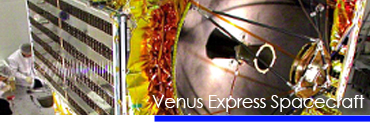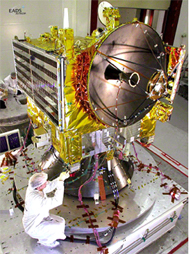
The Venus Express mission re-uses the Mars Express spacecraft with some modifications mainly driven by four times higher solar flux at Venus and the need to accommodate non-MEX instruments. This approach allowed ESA to minimize the costs and development risk and eventually guaranteed readiness for the launch in November 2005.
Venus Express is a 3-axis stabilized spacecraft. It employs two body-mounted high-gain and one low-gain antennae for telecommunications with the ground stations. The propulsion system uses a single main engine for orbit capture and eight small thrusters for attitude control and orbit maintenance maneuvers. The spacecraft attitude measurements and control are performed using star trackers and gyros. Reaction wheels are used for almost all attitude maneuvers, providing flexibility and accuracy.
The Venus Express electrical system is designed to satisfy the design driving requirements of an interplanetary spacecraft mission such as high autonomy, due to the absence of real time control of the spacecraft from Earth, and the ability to cope with a highly variable environment, in particular, a wide variation in the intensity of sunlight on the solar panels and broad temperature range of solar cells. Electrical power is generated by two symmetrical Gallium Arsenide solar arrays with a total area of 5.7 square metres. The solar arrays will generate about 1400 W in Venus orbit. During eclipse or when spacecraft power demand exceeds solar array capacity, power is supplied by three 24 Ah Lithium-Ion batteries that combine low mass with high-energy efficiency.
The communications system includes a transponder capable of transmitting and receiving in S-Band as well as X-Band and four different antennas: two low-gain S-band antennae, one dual band high-gain 1.3 m antenna, and one high-gain X-band antenna with 0.3m diameter dish. Maximum downlink data rate at Venus is 228 kbps.
The Data Management System is in charge of telecommand distribution to the whole spacecraft as well as telemetry data collection from the spacecraft systems and payload. The onboard Solid State Mass Memory is used for data storage and has a capacity of 12 Gbits.
The Venus Express spacecraft has bi-propellant propulsion system. The main engine generates a thrust of 415 N, and is used for the Venus capture and apocenter lowering. Eight thrusters each capable of producing thrusts of 10 N are located in the lower corners of the spacecraft. They will be used for attitude control and orbit maintenance. Total propellant load is 570 kg that is higher than on Mars Express because of higher ΔV requirements for the capture burn.
More Information: ESA - Venus Express
